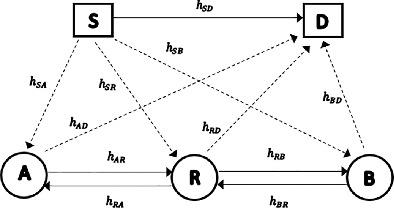当前位置:
X-MOL 学术
›
Trans. Emerg. Telecommun. Technol.
›
论文详情
Our official English website, www.x-mol.net, welcomes your
feedback! (Note: you will need to create a separate account there.)
Outage performance of cognitive two‐way amplify‐and‐forward relay network under different transmission schemes
Transactions on Emerging Telecommunications Technologies ( IF 2.5 ) Pub Date : 2020-06-08 , DOI: 10.1002/ett.4004 Raed T. Al‐Zubi 1 , Mohannad T. Abu Issa 1 , Omar Jebreil 2 , Khalid A. Darabkh 3 , Yazid Khattabi 1
Transactions on Emerging Telecommunications Technologies ( IF 2.5 ) Pub Date : 2020-06-08 , DOI: 10.1002/ett.4004 Raed T. Al‐Zubi 1 , Mohannad T. Abu Issa 1 , Omar Jebreil 2 , Khalid A. Darabkh 3 , Yazid Khattabi 1
Affiliation

|
In this article, we study an orthogonal frequency division multiplexing‐based underlay cognitive two‐way amplify‐and‐forward (AF) relay network. We assume a system model consists of a primary network that has two primary users (PUs) and a secondary network that has two secondary users (SUs) exchanging information in two‐way through a half‐duplex AF relay node. The introduced interference from the secondary network on the primary network should not exceed a maximum allowable level. In our study, we assume a channel model called hybrid channel model. Based on this model, the channels between the PUs and SUs are modeled using free‐space path loss model, while the channels between the SUs are modeled using Nakagami‐m fading model. We analyze the proposed system model in terms of signal‐to‐noise‐ratio (SNR) and outage probability (OP) under three different transmission schemes; two time slots, three time slots, and four time slots schemes. The SNR and OP at one end of the secondary network over the three transmission schemes are mathematically derived. Moreover, Monte Carlo simulation is used to verify derivations. Simulation results coincide well with theoretical results, confirming the correctness of our mathematical derivations. In addition, different scenarios of the system are studied, from which we conclude that different factors, like the transmitted power by the primary transmitter and the positions of primary transmitter and receiver as well as the relay node, have significant effect on the outage performance of the secondary network.
中文翻译:

不同传输方案下认知双向转发中继网络的中断性能
在本文中,我们研究了一种基于正交频分多路复用的底层认知双向转发(AF)中继网络。我们假设系统模型由一个具有两个主要用户(PU)的主网络和一个具有两个次要用户(SU)的次级网络组成,它们通过一个半双工AF中继节点双向交换信息。辅助网络在主网络上引入的干扰不应超过最大允许水平。在我们的研究中,我们假设一个称为混合渠道模型的渠道模型。基于此模型,使用自由空间路径损耗模型对PU和SU之间的信道进行建模,而使用Nakagami-m衰落模型对SU之间的信道进行建模。我们在三种不同的传输方案下,从信噪比(SNR)和中断概率(OP)方面分析了所提出的系统模型。两个时隙,三个时隙和四个时隙方案。数学上推导了三种传输方案下辅助网络一端的SNR和OP。此外,蒙特卡罗模拟用于验证推导。仿真结果与理论结果非常吻合,证实了我们数学推导的正确性。此外,研究了系统的不同情况,从中得出的结论是,不同的因素(例如,主发射机的发射功率以及主发射机和接收机以及中继节点的位置)对电网的中断性能有重大影响。辅助网络。两个时隙,三个时隙和四个时隙方案。数学上推导了三种传输方案下辅助网络一端的SNR和OP。此外,蒙特卡罗模拟用于验证推导。仿真结果与理论结果吻合良好,证实了我们数学推导的正确性。此外,研究了系统的不同情况,从中得出的结论是,不同的因素(例如,主发射机的发射功率以及主发射机和接收机以及中继节点的位置)对电网的中断性能有重大影响。辅助网络。两个时隙,三个时隙和四个时隙方案。数学上推导了三种传输方案下辅助网络一端的SNR和OP。此外,蒙特卡罗模拟用于验证推导。仿真结果与理论结果吻合良好,证实了我们数学推导的正确性。此外,研究了系统的不同情况,从中得出的结论是,不同的因素(例如,主发射机的发射功率以及主发射机和接收机以及中继节点的位置)对电网的中断性能有重大影响。辅助网络。蒙特卡罗模拟用于验证推导。仿真结果与理论结果吻合良好,证实了我们数学推导的正确性。此外,研究了系统的不同情况,从中可以得出结论,不同的因素(例如,主发射机的发射功率以及主发射机和接收机以及中继节点的位置)对电网的中断性能有重大影响。辅助网络。蒙特卡罗模拟用于验证推导。仿真结果与理论结果吻合良好,证实了我们数学推导的正确性。此外,研究了系统的不同情况,从中得出的结论是,不同的因素(例如,主发射机的发射功率以及主发射机和接收机以及中继节点的位置)对电网的中断性能有重大影响。辅助网络。
更新日期:2020-06-08
中文翻译:

不同传输方案下认知双向转发中继网络的中断性能
在本文中,我们研究了一种基于正交频分多路复用的底层认知双向转发(AF)中继网络。我们假设系统模型由一个具有两个主要用户(PU)的主网络和一个具有两个次要用户(SU)的次级网络组成,它们通过一个半双工AF中继节点双向交换信息。辅助网络在主网络上引入的干扰不应超过最大允许水平。在我们的研究中,我们假设一个称为混合渠道模型的渠道模型。基于此模型,使用自由空间路径损耗模型对PU和SU之间的信道进行建模,而使用Nakagami-m衰落模型对SU之间的信道进行建模。我们在三种不同的传输方案下,从信噪比(SNR)和中断概率(OP)方面分析了所提出的系统模型。两个时隙,三个时隙和四个时隙方案。数学上推导了三种传输方案下辅助网络一端的SNR和OP。此外,蒙特卡罗模拟用于验证推导。仿真结果与理论结果非常吻合,证实了我们数学推导的正确性。此外,研究了系统的不同情况,从中得出的结论是,不同的因素(例如,主发射机的发射功率以及主发射机和接收机以及中继节点的位置)对电网的中断性能有重大影响。辅助网络。两个时隙,三个时隙和四个时隙方案。数学上推导了三种传输方案下辅助网络一端的SNR和OP。此外,蒙特卡罗模拟用于验证推导。仿真结果与理论结果吻合良好,证实了我们数学推导的正确性。此外,研究了系统的不同情况,从中得出的结论是,不同的因素(例如,主发射机的发射功率以及主发射机和接收机以及中继节点的位置)对电网的中断性能有重大影响。辅助网络。两个时隙,三个时隙和四个时隙方案。数学上推导了三种传输方案下辅助网络一端的SNR和OP。此外,蒙特卡罗模拟用于验证推导。仿真结果与理论结果吻合良好,证实了我们数学推导的正确性。此外,研究了系统的不同情况,从中得出的结论是,不同的因素(例如,主发射机的发射功率以及主发射机和接收机以及中继节点的位置)对电网的中断性能有重大影响。辅助网络。蒙特卡罗模拟用于验证推导。仿真结果与理论结果吻合良好,证实了我们数学推导的正确性。此外,研究了系统的不同情况,从中可以得出结论,不同的因素(例如,主发射机的发射功率以及主发射机和接收机以及中继节点的位置)对电网的中断性能有重大影响。辅助网络。蒙特卡罗模拟用于验证推导。仿真结果与理论结果吻合良好,证实了我们数学推导的正确性。此外,研究了系统的不同情况,从中得出的结论是,不同的因素(例如,主发射机的发射功率以及主发射机和接收机以及中继节点的位置)对电网的中断性能有重大影响。辅助网络。











































 京公网安备 11010802027423号
京公网安备 11010802027423号